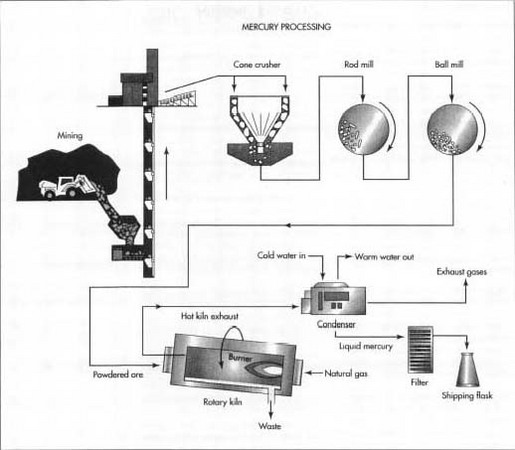|
Posted: 9/12/2014 12:07:51 AM EDT
On what used to be the outskirts of the city of Phoenix, and is now a residential area, mountain park, and resort is an area known as Dreamy Draw. This is rather an unusual name and begs the question of how it acquired that particular moniker.
Dreamy Draw is on the west side of the Phoenix Mountain Preserve, and the wash generally follows the route of SR 51 in between Piestewa Peak and Stoney Mountain:

Let's start with the history of mining in the area:
"In December of 1916, Sam Hughes, a Phoenix resident, discovered cinnabar deposits in the area now known as Dreamy Draw. Cinnabar, a mercury sulfide, had been discovered earlier that year in the area. Near his largest deposit, the Rico Mine, Sam Hughes erected a retort furnace, built a cabin, and sunk a main shaft and water well." 1
Rico Mercury Mine, circa 1930:

That being established, the activities of mining and refining mercury on the site have a strong nerve damaging effect on workers.
"...Dreamy Draw was a name residents coined in the early 20th century to describe the area where miners spent long and arduous days.
“It was said that the miners in this area would leave and be in a dreamy state so they were coming back from the Dreamy Draw," said John Southard, a Phoenix area historian.
That’s because of what the miners were looking for. Southard said miners here began digging for copper in 1916. But instead, discovered a significant amount of cinnabar. That’s a mineral that’s processed down to extract mercury – which was a commodity at a time when a world war was raging.
“In fact, mercury is a neurotoxin and working with mercury can have some very interesting effects on people. If you were to be in a mine shaft or working with materials, processing it, things like that, it is entirely likely that it could have an impact on your health and state of mind," Southard said." 2
Mercury poisoning symptoms:

The Arizona Department of Mines publication disagrees with the assessment of "dreamy miners" causing the name of the wash to become Dreamy Draw.
"Dreamy Draw, which lies along the western end of Squaw Peak, was named for the effects of intense exposure to mercury. It is not named for any such effects occurring in that area." 3
This is backed up by a description of the refining process taking place onsite:
"Ore brought to the plant arrived via a tramway to a 1.0 inch grizzly (sieve mechanism) which sorted the material into a 6 by 14 ft Wheeling jaw crusher powered by a 20 h.p. high torque U.S. motor. The crushed material then passed through a vertical 35 foot elevator and was deposited into a 40 ton bin. From the bin, a feeder system carried the material into a rotary kiln measuring 3 ft by 30 ft and lined with fire brick. Depending on the grade of the ore, the trip through the kiln took between 11 and 18 minutes. At the end of the kiln the calcined material, at a temperature of approximately 950 degrees Fahrenheit dropped into a 20 ft cubic cooling chute and then into cars which took the waste to a dump area, while the "volatilized mercury with the products of combustion" passed into a small dust collector, through a Sorrocco blower, and then into a six-unit Hartman cast iron condenser. The condenser concentrated much of the mercury which then ran into water seals which extracted most of the mercury; however, the finely divided mercury particles held in suspension by the residual gases then passed into a baffled redwood tank for additional cooling using water. From the redwood tank the gases went into a second tank that removed "almost the last traces of any mercury particles carried by the smoke". The processed gases then exited through a stack and no more than one or two ounces of mercury a day were thought to have been lost through the stack." 4
Mercury processing from cinnabar ore:

Mining activites ceased here by the 1940's, as the population moved north from the city center of Phoenix and the demand for mercury decreased. The site of the old Rico Mine is currently covered by the highway interchange at Northern and SR 51. The area is now a neighborhood dominated by a resort hotel with a water park, while the nearby mountains are a mountain park.

1 Bain, Diane. A REVIEW OF MERCURY MINING IN THE PHOENIX MOUNTAINS, MARICOPA COUNTY, Circular 103, Arizona Department of Mines and Mineral Resources, November, 2003, page 1.
2 http://kjzz.org/content/5252/did-you-know-how-dreamy-draw-got-its-name
3 Bain, page 2.
4 Stone, Lyle M., AN ARCHAEOLOGICAL AND HISTORICAL EVALUATION OF MERCURY MINING AND ORE PROCESSING SITES IN THE PHOENIX MOUNTAINS OF CENTRAL PHOENIX, MARICOPA COUNTY, ARIZONA, Archaeological Research Services, Inc., Tempe Arizona, August, 1990, page 34.
|
 Win a FREE Membership!
Win a FREE Membership!